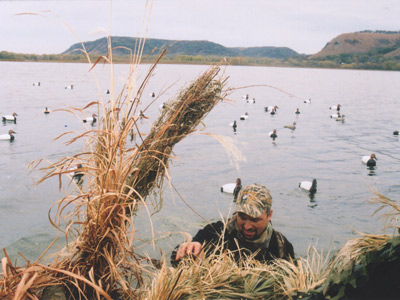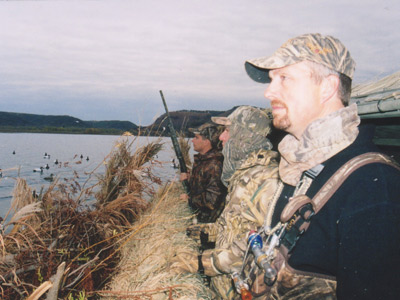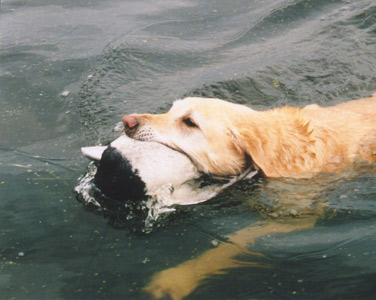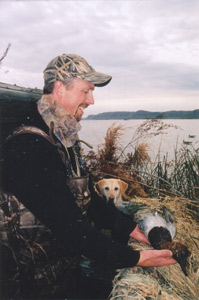A MEETING WITH THE KING...Migrating canvasbacks, hunters arrive on Mississippi
By Dick Ellis
Reader Note: This trip took place in 2004. Be sure to check current regulations when planning your own trip. Connect with Flyway Fowling Guide Service, Captain Todd Lensing and the Grandview Motel at 608-734-3235, grandviewmotel@centurytel.net or www.flywayfowling.com. Connect with the Ferryville Tourism Council in Crawford County and Executive Director Sherry Quamme at www.visitferryville.com, squamme@centurytel.net or 608-734-9077.
For several hours far out in a floating blind rocking gently on Pool 9 of the Mississippi River near Lynxville, Kevin Kelly and Earl McLean had awaited the arrival of the King. Canvasbacks, which have earned a royal reputation among duck hunters due to its great size of three pounds or more, extraordinary flight speeds to 75 miles per hour, and excellence as table fare, will stage in numbers surpassing 300,000 on the Mississippi River from Trempealeau to Prairie du Chien by mid November.
On this October 18th morning, state and federal aerial surveys have placed “Can” collective migration numbers on staging waters Pools 7, 8, and 9 at just under 17,000 birds as they begin to congregate on their annual journey to wintering homes on Chesapeake Bay on the Atlantic coast and several Gulf Coast states. Although the guns of November will thunder with the swelling numbers of Cans to arrive in the weeks ahead, Kelly and McLean, of Lancaster, had kept watch over 150 decoys set down in the predawn black by Todd Lensing of Flyway Fowling Guide Service; and hoped for encounters with the early birds.

With only some of the 150 canvasback and other decoys visible behind him, guide Todd Lensing makes camouflage adjustments to his blind on Pool 9 of the Mississippi River Monday. More than 300,000 `Cans’ will congregate on the Mississippi River in the next two weeks on their migration to wintering territories on the east coast and gulf states.
The wish is granted when a lone canvasback materializes from nowhere and the drake streaks low over the decoys in all its glory and speed. The “bull” is beautifully adorned with maroon head and neck feathers transitioning to a black breast and whitish body. Kelly recovers from the initial surprise and stands to swing the lead of the 12-gauge scattergun far ahead of the bird. A lone shotgun report announces that a King is dethroned as the Can tumbles among the decoys from the full load of #03 shot.
“That was Kevin’s first canvasback,” said Lensing following a business-like retrieve by Sage, his Hunting Retriever Champion (HRCH) yellow lab. “This is one of the only places in North America where a hunter can take a canvasback. To see a hunter take his first bird is a thrill for me. It’s what I like most about being a guide.”
And a very good one, he is. The work the U.S. Coast Guard Licensed Guide invests in each hunt is extraordinary. After a 3:00 a.m. rendezvous in Lancaster, these guests traveled one hour to Lynxville and launched the boat that would serve as a blind when legal shooting time arrived three hours later.
The 18-foot Outlaw Duck Boat offers comfortable shooting areas for three hunters, carries a three-quarter camouflaged top and has cargo space for hundreds of decoys and the cooking necessities for an onboard, Lensing produced big man’s breakfast. A shield of vegetation helps to further conceal the hunters until popping up as the gunner rises for the shot. The entire boat-blind has been meticulously grassed from top to bottom by Lensing to blend in with the vegetation stands sporadically protruding from the shallow water of Pool 9.
Before 5:00 a.m., Lensing had staked claim to a prime location from the 25 huntable miles of Pool 9. One hour prior to legal shooting time, he began the monumental task of setting decoys in four feet of water over a hard, sandy bottom. The 150 “blocks” included 72 Cans, 15 divers, mallards, widgeon, gadwall, and confidence decoys that include four Canadian geese and a pair of swans. Canvasbacks are not the only ducks that frequent the Mississippi Flyway. Lensing’s unique decoy layout invited both puddle ducks and divers in two distinct areas in front of the shooters to land and rest.

Guide Todd Lensing (foreground), Earl McLean and Kevin Kelly scan the skies over 150 decoys set on Mississippi River Pool 9 near Lynxville Monday. The area draws approximately one half of the North American canvasback population during the duck’s annual migration. In the next two weeks, more than 300,000 `Cans’ are expected.
Mission accomplished the guide settled back into the boat to await another sunrise and began the quiet discussion that throughout the Canvasback season from October 16 through November 14 will introduce in detail his guests to the intriguing bird, and this very unique season. Lensing does not hunt in order to better serve his clients, but instead concentrates on safety concerns, duck identification, duck calling, and dog handling.
“Canvasbacks migrate from Canada and winter on Chesapeake Bay on the east coast and primarily on Lake Cathoula in Louisiana on the Gulf Coast,” he said. “Pool 9 is a major staging area on the migration. To have a canvasback hunting season, there has to be at least 500,000 birds in North America based on aerial surveys. The canvasback estimate this year is 617,000. Hunters may take one bird only per day.”

Sage, Todd Lensing’s Hunting Retriever Champion (HRCH) yellow lab, makes a business-like retrieve on a bull canvasback dropped by Kevin Kelly of Lancaster Monday Morning on Pool 9 of the Mississippi River near Lynxville.
With roughly half of the North American canvasback population staging on primarily three Mississippi River Pools, Lensing’s description of what hunters can expect is compelling. His words would make most Wisconsin waterfowlers want to experience a Can hunt, at least once.
“The average canvasback flock is 20 to 40 birds,” he said. “They’re a tough bird; I recommend number two or three shot; fours won’t do it. But a Can is also a decoyable bird. When you get a couple hundred decoying at one time, they’ll see the decoys from high up, cup their wings, break up and just rain down out of the sky before regrouping and making two or three circle passes. Picture the whistling wings of that many birds as they pass over the blind before setting over the decoys. Now that is a sight.”
Just a lone Canvasback streaking low and fast over the decoys was a welcome sight for Kevin Kelly. And watching Sage return with the bull held gently in her mouth after the well placed shot was too.
“This is one of the premiere locations in the Midwest to hunt canvasbacks,” Kelly said. “For us to have it right in our backyard gives us a great opportunity, a rare opportunity to hunt a very unique bird.”

Guide Todd Lensing examines the drake canvasback taken by Kevin Kelly of Lancaster Monday on Pool 9 of the Mississippi River. Sage, Lensing’s Hunting Retriever Champion (HRCH) yellow lab, made the retrieve.
For more information on Flyway Fowling Guide Service connect with www.flywayfowling.com or call Todd Lensing at 1-608-723-6825.
MISSISSIPPI, DIVERSE HUNTING CALLS WATERFOWLERS FROM AFAR
The beauty and mystique of the Mississippi River combine with diverse duck hunting to draw waterfowlers from throughout the country for a few days Of “Blind” love all along western Wisconsin.
“We might have opportunities here on mallards, bufflehead, green wing or bluewing teal, goldeneye, redheads,” said Todd Lensing of Flyway Fowling Guide Service. “Last year our hunters took 15 species of ducks, and nine different species on one day. I have people coming here from all over the country to hunt canvasback. Traditionally by the third week of October through the first week of November there will be fabulous canvasback hunting. But the hunters come for the Mississippi too. This is a famous river. People are intrigued by it.”
The admiration from afar is not an idea lost on the local hunters. “We take the Mississippi for granted because we’ve been here all our lives,” said McLean. “But where would we be without it?”
The Mississippi River can also be a dangerous river. Lensing preaches safety, from mandatory life jacket use when the boat is in motion, to detailed instructions of each hunter’s acceptable range of shooting from the blind, to mandatory unloading of a shotgun when nature calls and the hunter must leave the blind area for the boat deck.
“Between here and Prairie du Chien about 25 hunters lost their lives in the 1950s when an unexpected storm came on with freezing temperatures and high winds,” Lensing said. “High winds can make this so dangerous with four foot rollers. Last year an 18-foot boat took on water and sunk. Safety is our number one concern.”
CANVASBACKS...INSIGHT FROM A MISSISSIPPI RIVER BIOLOGIST
According to Mississippi River Wildlife Biologist Mark Andersen working from Lacrosse, migrating canvasbacks are traveling to wintering areas primarily on the Atlantic coast at Chesapeake Bay and the Gulf coast including Florida, Alabama, Mississippi and Louisiana from nesting territories in North Dakota, Manitoba, Saskatchewan, and western Ontario. 50 percent of the entire North American canvasback population currently estimated at 617,000 birds, Andersen said, use Mississippi River pools north and south of LaCrosse as staging areas on that migration, with other “Cans” using the Pacific flyway and routes east of Wisconsin.
“There has been a historic shift in the canvasback migration which also used to include the Winnebago pool lakes and other lakes to the east,” said Andersen. “Loss of habitat and probably the increase of recreational traffic on those lakes caused the canvasbacks to use other routes. Lake Christina, a several thousand acre, shallow lake in west central Minnesota also used to be famous canvasback staging area but higher water levels and loss of desirable vegetation due to carp, bullheads and buffalo uprooting the plants initiated a shift in the bird’s migration route.”
Loss of desirable vegetation and the Cans primary food sources including wild celery, sago and other pond weeds on the Mississippi has led to a shift on the river pools used by the canvasback. The bird’s diet also includes fingernail clams and large, mud-burrowing insect larvae. Twenty years ago, according to Andersen, Cans congregated evenly from Pool 4 in the north near Alma south to Pool 9 near Lynxville. Today, canvasbacks are concentrated primarily on Pools 7, 8, and 9.
“This year numbers will probably peak at around 300,000 canvasbacks using pools 7, 8 and 9 from Trempealeau to Lynxville,” Andersen said. “Numbers peak earlier on Pool 7 and Lake Onalaska the last week of October and the birds move to Pool 8 and 9 about one week later. The peak varies on the pools with numbers on Pool 7 as high as 100,000, Pool 8 numbers about that high, and Pool 9 canvasback numbers as high as 200,000.”
Aerial population surveys are done weekly by both the United States Fish & Wildlife Service (USFWS) and the Wisconsin DNR, depending on weather and other pilot responsibilities including fire control, Andersen said. The USFWS coordinates numbers surveys on Pools 4 through 8, and Pools 12 and 13 near Savannah Illinois. Since recent budget cuts in Wisconsin, that federal service also compensates the Wisconsin DNR to coordinate population surveys on Pools 9, 10, and 11 from Genoa, Wisconsin to Dubuque, Iowa.
As of the week of October 14, approximately 5,000 canvasbacks were counted on Pool 9, 4,530 Cans on Pool 8, and 7,390 Cans on Pool 7. “So we have a long way to go before we reach peak numbers,” Andersen said. (Just prior to release of this column October 21, Andersen said Can numbers on Pool 9 had grown to 24,000, Pool 8 had grown insignificantly to 7,460 and Pool 7 had swollen to 16,725)
The arrival of the canvasback is hailed in particular by hunters as the annual coming of the King of Ducks. That reputation was earned by the bird’s uncanny ability to fly at speeds reaching 70 to 75 miles per hour and great size often reaching more than three pounds. The bird also decoys relatively easily and is considered great table fare.
The ducks great taste, in fact, led to canvasback numbers being decimated by market hunters in the late 1800s and early 1900s. A brace of two Cans commanded top dollar from fine restaurants.
Commercial hunters, Andersen said, floated in on rafts of canvasbacks consisting of vast numbers of the birds and unleashed a variety of loads from punt guns that could discharge traditional shot, chopped nails or basically anything small and hard. By having ready several punt guns from raft-like boats, Andersen said, market hunters had the equivalent of small cannons and the ability to dispatch great numbers of canvasbacks with little effort.
With Canvasback and other waterfowl numbers in severe decline, market hunting and the use of live decoys were eliminated in the 1920s. The damage was done, however, and waterfowl numbers already severely depleted were further harmed by Mother Nature. Severe drought and the Dust Bowl years of the 1930s destroyed nesting habitat and waterfowl production. The crises, Andersen said, prompted the birth of such organizations like Ducks Unlimited and the Delta Waterfowl Association almost 80 years ago focusing on the importance of habitat restoration to assist waterfowl production.







